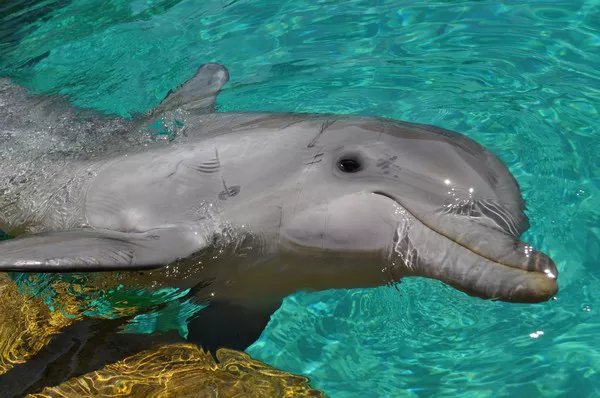Intelligence in mammals has long fascinated scientists and enthusiasts alike. From problem-solving abilities to social complexities, various species exhibit remarkable cognitive prowess. In this article, we embark on a journey to explore the most intelligent mammals, delving into their cognitive abilities, social structures, and the factors that contribute to their exceptional intellect.
5 Most Intelligent Mammals
1. Dolphins:
Dolphins are widely recognized as one of the most intelligent mammals, renowned for their complex social behaviors, communication skills, and problem-solving abilities. These highly social marine mammals inhabit oceans worldwide and display a remarkable capacity for learning and adaptation.
Central to dolphin intelligence is their intricate communication system, which includes a diverse range of vocalizations, body language, and cooperative behaviors. Dolphins use echolocation to navigate their environment and locate prey, demonstrating sophisticated sensory abilities.
Moreover, dolphins exhibit complex social structures, forming strong bonds within their pods and engaging in cooperative hunting and caregiving behaviors. Research has also shown evidence of cultural transmission within dolphin populations, with distinct behaviors passed down through generations.
Furthermore, dolphins have demonstrated impressive problem-solving skills in captivity, mastering tasks such as object manipulation, tool use, and understanding symbolic representations. Their ability to learn and innovate in novel environments underscores their cognitive flexibility and adaptability.
2. Chimpanzees:
As our closest living relatives, chimpanzees exhibit remarkable cognitive abilities and social complexities that rival those of humans. These highly intelligent primates inhabit the forests of equatorial Africa and are renowned for their tool use, problem-solving skills, and complex social structures.
Chimpanzees display a diverse repertoire of tool use, ranging from using sticks to extract termites from mounds to using stones to crack open nuts. Their ability to modify and innovate tools for specific tasks highlights their cognitive flexibility and problem-solving prowess.
Moreover, chimpanzees exhibit sophisticated social behaviors, forming complex hierarchies within their communities and engaging in cooperative hunting, grooming, and alliance formation. They also demonstrate empathy, altruism, and cultural traditions passed down through generations.
Furthermore, research has shown evidence of chimpanzees’ understanding of symbolic communication, with individuals able to learn sign language and communicate with humans. Their ability to understand and respond to human gestures and vocalizations highlights their cognitive versatility.
3. Elephants:
Despite their massive size, elephants are renowned for their exceptional intelligence, emotional depth, and social complexity. These majestic mammals inhabit diverse habitats across Africa and Asia and exhibit a range of cognitive abilities, including problem-solving, memory, and social cognition.
Central to elephant intelligence is their highly developed social structure, characterized by strong family bonds, cooperation, and communication. Elephants live in matriarchal groups led by experienced females who guide their herds to food and water sources and protect them from predators.
Moreover, elephants demonstrate remarkable memory capabilities, with individuals able to remember complex spatial information, such as the location of distant watering holes, over long periods. Their ability to navigate vast landscapes and recognize familiar individuals highlights their cognitive acumen.
Furthermore, elephants exhibit empathy, altruism, and mourning behaviors, displaying profound emotional connections within their social groups. Research has also shown evidence of elephants’ ability to understand human gestures and vocalizations, indicating a level of cross-species communication.
4. Orcas:
Orcas, also known as killer whales, are apex predators of the ocean and exhibit remarkable intelligence, social complexity, and communication skills. These highly adaptable marine mammals inhabit oceans worldwide and display a diverse range of behaviors, from cooperative hunting to intricate vocalizations.
Central to orca intelligence is their complex social structure, with individuals living in matrilineal groups led by experienced females. Within these groups, orcas engage in cooperative hunting, communication, and caregiving behaviors, demonstrating a strong sense of social cohesion.
Moreover, orcas display sophisticated hunting strategies, including coordinated attacks on prey and cooperative sharing of food within their pods. Their ability to communicate and coordinate effectively during hunts underscores their cognitive prowess and social intelligence.
Furthermore, orcas exhibit a diverse range of vocalizations, including clicks, whistles, and calls, which serve various communication functions within their social groups. Research has also shown evidence of cultural transmission within orca populations, with distinct vocal dialects and behaviors passed down through generations.
5. Bonobos:
Bonobos, often referred to as the “forgotten ape,” are closely related to chimpanzees and exhibit remarkable intelligence, empathy, and social behavior. These endangered primates inhabit the dense forests of the Democratic Republic of Congo and display a range of cognitive abilities, including problem-solving, cooperation, and communication.
Central to bonobo intelligence is their complex social structure, characterized by female dominance, cooperation, and conflict resolution through affiliative behaviors. Bonobos use sexual activity as a means of reducing tension and forming social bonds within their communities.
Moreover, bonobos exhibit sophisticated problem-solving skills, including tool use and innovation in foraging and food extraction. Their ability to adapt to changing environments and exploit resources effectively underscores their cognitive flexibility and ingenuity.
Furthermore, bonobos demonstrate empathy, altruism, and social reciprocity, engaging in cooperative behaviors such as food sharing and mutual grooming. Research has also shown evidence of bonobos’ understanding of symbolic communication, with individuals able to learn human gestures and interact with researchers.
See Also:10 Most Rarest Mammals In The World
A Quick Review:
In conclusion, the most intelligent mammals exhibit a diverse array of cognitive abilities, social complexities, and adaptive behaviors that underscore their remarkable intelligence. From dolphins’ intricate communication skills to elephants’ emotional depth and social cognition, these mammals demonstrate the complexity and richness of the animal kingdom.
Understanding the cognitive abilities of these mammals not only provides insights into their evolutionary history and ecological roles but also raises important questions about our relationship with other species and the ethical considerations of their conservation and welfare. As we continue to unravel the mysteries of animal intelligence, it is essential to recognize and appreciate the cognitive marvels of the natural world.
You Might Be Interested In:
- Animals in the World – You May Not Know” href=”https://www.validdownloads.com/archives/2541″ rel=”bookmark”>20 Cutest Animals In The World – You May Not Know
- 8 Animals With Unusual Behaviors
- World’s 5 Cleanest Animals – You May Not Know
























